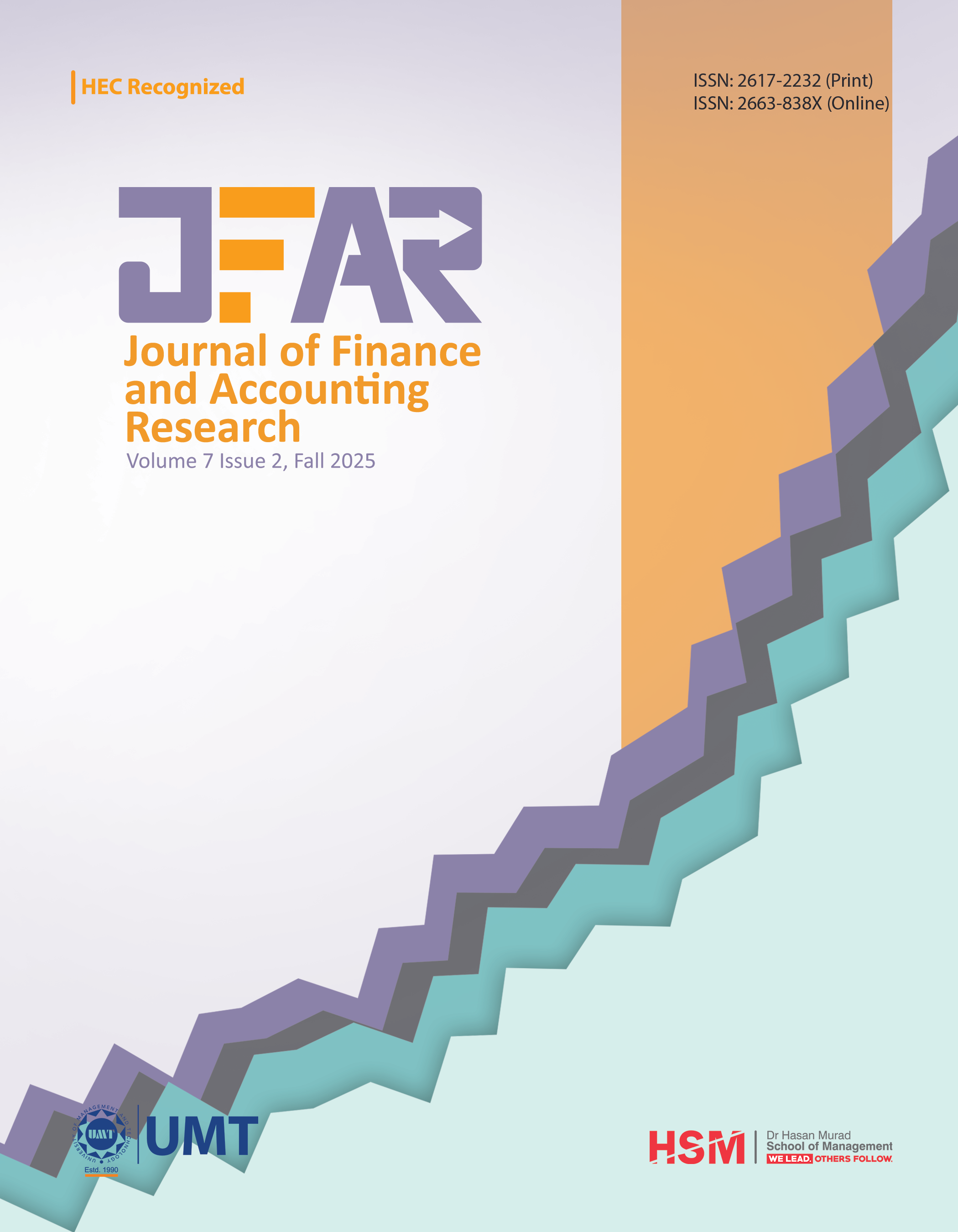Measuring Financial Stress for Emerging and Developed Countries
Abstract
The current study adopted a comprehensive approach by developing monthly Financial Stress Indices (FSIs) for emerging and developed countries. The study built indices for 20 emerging economies at the country, aggregate, and region levels from January 1997 to December 2016. Similarly, the study constructed monthly FSIs at country and aggregate levels for 23 developed countries, covering the period from January 1993 to December 2016. Principal Component Analysis (PCA) was applied to develop these FSIs. The study determined that political risk is crucial in systemic Financial Stress (FS) in emerging countries, whereas financial and economic risk contribute significantly more to FS in developed countries. The study's unique contribution is the inclusion of political risks in constructing stress indices alongside economic and financial risks. It underscores the importance of promoting regional policy coordination and reducing domestic vulnerabilities to maintain financial stability.
Downloads
References
Ahir, H., Dell'Ariccia, G., Furceri, D., Papageorgiou, C., & Qi, H. (2023). Financial stress and economic activity: Evidence from a new worldwide index. IMF e Library. https://doi.org/10.5089/9798400257636.001
Balakrishnan, R., Danninger, S., Elekdag, S., & Tytell, I. (2011). The transmission of financial stress from developed to emerging economies. Emerging Markets Finance and Trade, 47(2), 40–68. https://doi.org/10.2753/REE1540-496X4703S203
Bank of International Settlements. (2009). International banking and financial market developments. https://www.bis.org/publ/qtrpdf/r_qt0903.htm
Bollerslev, T., Chou, R., & Kroner, K. F. (1992). ARCH modeling in finance: A review of the theory and empirical evidence. Journal of Econometrics, 52(1-2), 5–59.
Burnside, C., Eichenbaum, M., & Rebelo, S. (2004). Government guarantees and self-fulfilling speculative attacks. Journal of Economic Theory, 119(1), 31–63. https://doi.org/10.1016/j.jet.2003.06.002
Cerra, V., & Saxena, S. C. (2000). An alternative method of estimating potential output and the output gap: An application to Sweden. IMF eLiberary. https://doi.org/10.5089/9781451847932.001
Cevik, E. I., Dibooglu, S., & Kenc, T. (2013a). Measuring financial stress in Turkey. Journal of Policy Modeling, 35(2), 370–383. https://doi.org/10.1016/j.jpolmod.2012.06.003
Cevik, E. I., Dibooglu, S., & Kutan, A. M. (2013b). Measuring financial stress in transition economies. Journal of Financial Stability, 9(4), 597–611. https://doi.org/10.1016/j.jfs.2012.10.001
Copelovitch, M., Frieden, J., & Walter, S. (2016). The political economy of the Euro crisis. Comparative Political Studies, 49(7), 811–840. https://doi.org/10.1177%2F0010414016633227
Dahalan, J., Abdullah, H. B., & Umar, M. (2016). Measuring financial stress index for the Malaysian economy. International Journal of Economics and Financial Issues, 6(3), 942–947. https://econpapers.repec.org/article/ecojourn1/2016-03-16.htm
Danielsson, J., & Macrae, R. (2016). The fatal flaw in macropru: It ignores political risk. LES Research Online. https://eprints.lse.ac.uk/70703/2/Danielsson_The%20fatal%20flaw%20in%20macropru_published_2016%20LSERO.pdf
Gomis-Porqueras, P., Ruprecht, R., & Zhou, X. (2023). A financial stress index for a small open economy: The Australian case [Working Paper No. 2023-29]. FEDS. http://dx.doi.org/10.17016/FEDS.2023.029
Herrera, H., Ordonez, G., & Trebesch, C. (2020). Political booms, financial crises. Journal of Political Economy, 128(2), 507–543. https://doi.org/10.1086/704544
Hollo, D., Kremer, M., & Marco, L. (2012). CISS – A composite indicator of systemic stress in the financial system [Working Paper No 1426]. European Central Bank. https://dx.doi.org/10.2139/ssrn.2018792
Hrifa, A., & Mehdi, M. (2023). Essays on the measurement of pressure on the foreign exchange market in Morocco. African Scientific Journal, 3(15), 835–835. https://doi.org/10.5281/zenodo.7598166
Illing, M., & Liu, Y. (2006). Measuring financial stress in a developed country: An application to Canada. Journal of Financial Stability, 2(3), 243–265. https://doi.org/10.1016/j.jfs.2006.06.002
International Monetary Fund. (2009a). Global financial stability report: Responding to the financial crisis and measuring systemic risk. IMF eLibrary. https://doi.org/10.5089/9781616352080.082
International Monetary Fund. (2009b). Guidance to assess the systemic importance of financial institutions, markets, and instruments: Initial considerations. International Monetary Fund. https://www.imf.org/external/np/g20/pdf/100109.pdf
International Monetary Fund. (2015a). Global financial stability report: Navigating monetary policy challenges and managing risks. IMF eLibrary. https://doi.org/10.5089/9781498372930.082
International Monetary Fund. (2015b). Global financial stability report: Vulnerabilities, legacies, and policy challenges: Risks rotating to emerging markets. IMF eLibrary. https://doi.org/10.5089/9781513582047.082
International Monetary Fund. (2024). The last mile: Financial vulnerabilities and risks. IMF Stability Report.
Kadiric, S. (2022). The determinants of sovereign risk premiums in the UK and the European government bond market: The impact of Brexit. International Economics and Economic Policy, 19(2), 267–98. https://doi.org/10.1007/s10368-022-00535-8
Laeven, L., & Valencia, F. (2013). Systemic banking crises database. IMF Economic Review, 61(2), 225–270. https://doi.org/10.1057/imfer.2013.12
Ma, Y., Wei, Q., & Gao, X. (2024). The impact of political risks on financial markets: Evidence from a stock price crash perspective. International Journal of Financial Studies, 12(2), e51. https://doi.org/10.3390/ijfs12020051
Misina, M., & Tkacz, G. (2009). Credit, asset prices, and financial stress. International Journal of Central Banking, 5(4), 95–122.
Oet, M., Dooley, J., & Ong, S. (2015). The financial stress index: Identification of systemic risk conditions. Risks, 3(3), 420–444. https://doi.org/10.3390/risks3030420
Park, C. Y., & Mercado, R. V. (2014). Determinants of financial stress in emerging market economies. Journal of Banking and Finance, 45(8), 199–224. https://doi.org/10.1016/j.jbankfin.2013.09.018
Pinto, B., & Ulatov, S. (2010). Financial globalization and the Russian crisis of 1998. YPFS Resource Library. https://elischolar.library.yale.edu/cgi/viewcontent.cgi?article=14314&context=ypfs-documents
PRS Group. (2016). International country risk guide database. https://www.prsgroup.com/explore-our-products/icrg/
Reinhart, C. M., & Rogoff, K. S. (2009). This time is different - Eight centuries of financial folly. Princeton University Press.
Sadia, H., Bhatti, A. A., & Ahmad, E. (2019). Developing a financial stress index for Pakistan. Business and Economic Review, 11(4), 113–132. https://doi.org/10.22547/BER/11.4.5
Sandahl, J. F., Holmfeldt, M., Ryden, A., & Stromqvist, M. (2011). An index of financial stress for Sweden. Sveriges Riksbank Economic Review, (2), 49–67.
Stolbov, M., & Shchepeleva, M. (2025). A sentiment-based financial stress index for Russia. Borsa Istanbul Review, 25(2), 350–359. https://doi.org/10.1016/j.bir.2025.01.007
Thakor, A. V. (2015). The financial crisis of 2007–2009: Why did it happen and what did we learn? Review of Corporate Finance Studies, 4(2), 155–205. https://doi.org/10.1093/rcfs/cfv001
Titman, S., Keown, A. J., & Martin, J. D. (2011). Financial management: Principles and applications. Pearson.
Turner, P. (2007). Are banking systems in East Asia stronger? Asian Economic Policy Review, 2(1), 75–95. https://doi.org/10.1111/j.1748-3131.2007.00052.x
van Norden, S. (2024). Output gaps: Editor’s introduction. Journal of Business Cycle Research, 20, 51–54. https://doi.org/10.1007/s41549-024-00101-y
Waszkiewicz, G. (2017). Political risk on financial markets in developed and developing economies. Journal of Economics and Management, 28(2), 112–132.
World Bank. (2017). Global economic monitor database. https://databank.worldbank.org/source/global-economic-monitor-(gem)
World Economic Forum. (2025). The global risk report 2025: 20th edition. https://reports.weforum.org/docs/WEF_Global_Risks_Report_2025.pdf
Copyright (c) 2025 Haleema Sadia, Jawad Ahmad Azeez

This work is licensed under a Creative Commons Attribution 4.0 International License.
JFAR follows an open-access publishing policy and full text of all articles is available free, immediately upon acceptance. Articles are published and distributed under the terms of the Creative Commons Attribution 4.0 International License. Thus, work submitted to UMT Journals implies that it is original, unpublished work of the authors; neither published previously nor accepted/under consideration for publication elsewhere. On acceptance of a manuscript for publication, a corresponding author on the behalf of all co-authors of the manuscript will sign and submit a completed Author Consent, Copyright, and Declaration Form.







